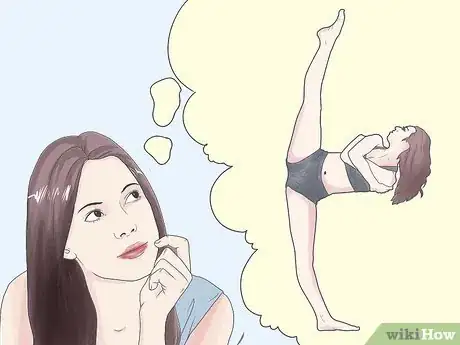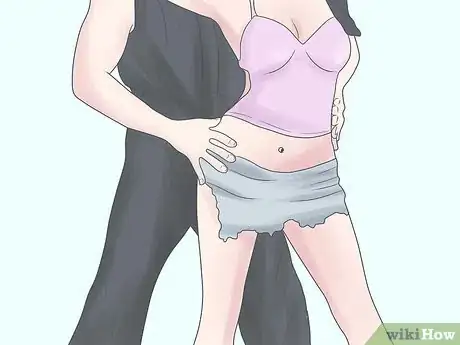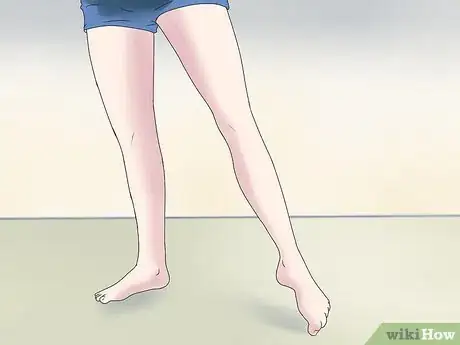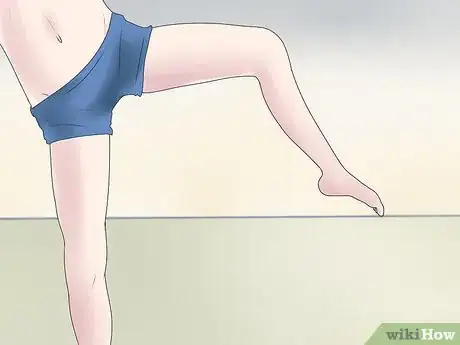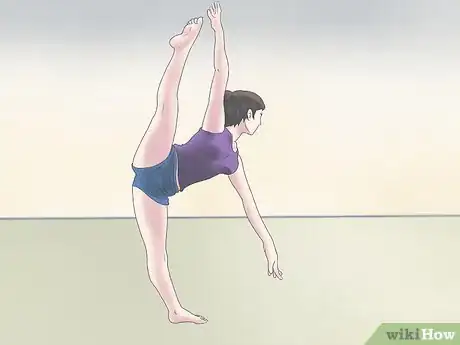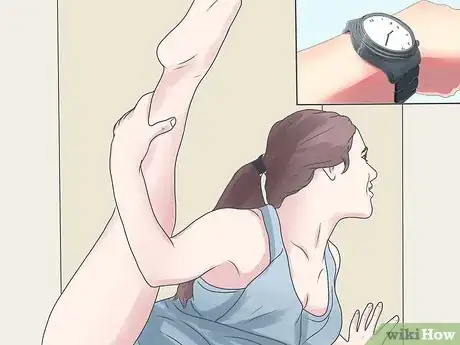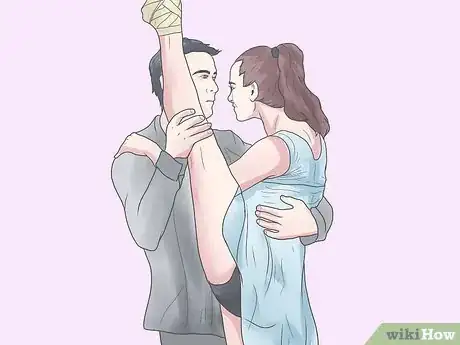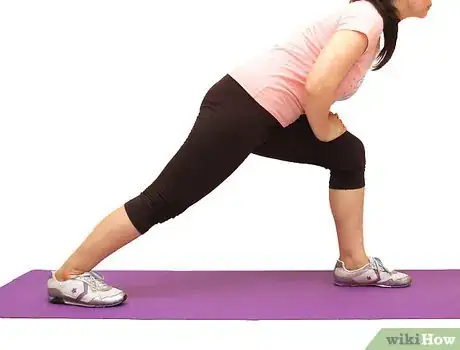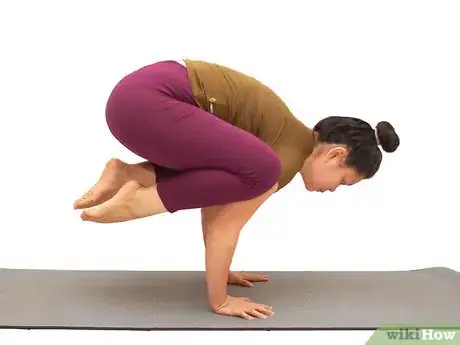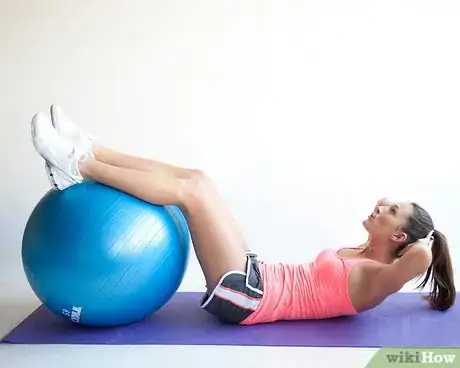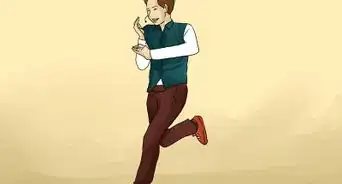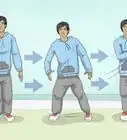wikiHow is a “wiki,” similar to Wikipedia, which means that many of our articles are co-written by multiple authors. To create this article, 18 people, some anonymous, worked to edit and improve it over time.
This article has been viewed 121,273 times.
Learn more...
In dance, doing a "tilt" or a "leg tilt" usually means pulling a breathtaking move that involves performing a vertical standing split and tilting the upper body to the side while maintaining balance. This difficult move can be done with a partner or solo. Being able to perform an effortless tilt requires a dancer to have impeccable flexibility and balance along with a great sense of rhythm and musical timing. See Step 1 below to start learning how to do a tilt!
Steps
Performing a Tilt
-
1Stretch before beginning. A tilt is an impressive feat of flexibility. It requires bending your body in a way that most people can't. As with any activity that requires intense bending or flexing, it's important to stretch beforehand to prevent injury. Focus on the types of stretches you would use before doing the splits - namely, hamstring, glute, groin, hip, and lower back stretches.
-
2Enlist a partner that can hold your weight. When watching an experienced dancer perform an amazing, acrobatic tilt, it's easy to forget that this move requires lots of practice and preparation. Most dancers won't be able to perform a perfect tilt on their first try - generally, dancers should expect to fail many times before they can pull a perfect tilt on demand. Because of this, if you haven't performed a tilt before, you should minimize the risk of injury from losing balance and falling by getting a partner to help. This partner should be patient, and, more importantly, strong enough to catch you if you fall.Advertisement
-
3Have your partner grab your upper waist from behind. Your partner should position him or herself behind you and put his or her hands just above your hips. From this position, s/he will be able to support your weight and help you keep balance as you make your tilt.
-
4Lift one leg and shift your weight to the other. In a tilt, the dancer keeps one foot on the ground while raising the other as high as it can go. Keeping one foot squarely planted on the ground, lift your other while bending your knee until your thigh is roughly parallel to the ground. As you do so, make minute adjustments with your core muscles and your foot on the ground to maintain your balance.
-
5Turn your foot on the ground outward. Keeping your other leg elevated, turn the toes of the foot touching the ground about ninety degrees outward - that is, your toes should face away from the center of your body. Turning your foot in this way makes it easier to perform the deep stretch involved in the tilt. Be careful to keep your balance as you perform this adjustment.
-
6Begin to lift your elevated leg as you lean. Carefully lift your elevated leg up as you lean your upper body in the opposite direction. Your bent leg should slowly raise and straighten above your hips - it may look like you're performing a very high karate kick. Have your partner support your raised leg with his or her hand on your calf. As you raise your leg, lean your upper body to the side until it is horizontal (or nearly so).
- Your partner can help you achieve a more vertical stretch by gently pulling your leg up, but be careful not to stretch your leg beyond its limits.
-
7Bend upwards with your upper body. As you lift your leg, your upper body should naturally bend toward the raised leg at the waist. As your upper body approaches a horizontal position, this will eventually mean it is bending upwards. Your hips should raise with your leg and push out to the rear.
-
8Hold this position as long as possible. Once you can reach this "final" position, it's time to work on your ability to hold your tilt on your own. To start, have your partner slowly and gently let go of your thigh while you attempt to hold it in its place. Over time, work to gradually increase the amount of time you can hold your twist until you can maintain your position indefinitely.
-
9Work towards tilting on your own. Finally, when you're confident performing the tilt with help from a partner, carefully begin to practice moving into and out of the tilt on your own. Doing so requires great balance and strong stabilizer muscles, so don't be surprised if you're unable to do your tilt the very first time you try. You may need to build significant core strength before you can tilt to your liking. A wall, pole, or even a sturdy piece of furniture can be helpful for supporting your weight as you work on your tilt. These things are somewhat less supportive than a careful partner, giving you an opportunity to gradually strengthen your ability to tilt.
-
10As an alternate move, lift your leg as you face your partner. The "normal" tilt described above is similar to performing a side-to-side split, while this move is similar to performing a front-to-back split. Try raising your leg over and around your partner as you face him or her. From this position, you can rest your leg against your partner's shoulder or even use the opportunity to perform a stretch.
- Note that this variation requires even-greater flexibility in your hamstrings.
Improving your Flexibility and Balance
-
1Focus on hamstring stretches. As noted above, you'll want to stretch all of the muscles involved in performing the splits before attempting a tilt - glutes, groin, lower back, hips, etc. Most important of all are the hamstrings. The flexibility of these muscles directly dictates how straightly you'll be able to extend your leg and how far you'll be able to stretch it. Luckily, adding any number of a wide variety of hamstring stretches to your fitness routine can help you improve flexibility in your hamstrings.
-
2Perform balance exercises. When holding a tilt, you're balanced on one leg with the other in the air and your upper body jutting out to the side. This is not an easy position to hold for any length of time without falling over. Doing so requires great balance, especially in the form of strong core and "stabilizer" muscles. Try adding balance-strengthening exercises to your fitness routine. These exercises help improve both your natural sense of balance and the stabilizing muscles you use for the tiny posture adjustments that keep you upright while performing a tilt.
-
3Strengthen your core. Finally, as in many other dance moves, a strong core is essential for performing tilts. Core muscles are vital for balancing and supporting your weight in awkward dance positions like the tilt. More importantly, a strong core can help prevent strain and injury, especially to the back, which can be debilitating for any type of athlete, dancers not excepted. So, be sure to incorporate plenty of core exercises into your fitness routine - crunches, planks, deadlifts, squats, and lunges, for starters.
Community Q&A
-
QuestionIf I can't do a middle split, is it still possible to do a tilt?
 Community AnswerYes, but it won't be a full tilt.
Community AnswerYes, but it won't be a full tilt. -
QuestionWhat if I don't have a partner to practice with?
 Community AnswerYou can use a wall or theraband instead of a partner.
Community AnswerYou can use a wall or theraband instead of a partner. -
QuestionI'm actually asking for my daughter. She's a dancer, quite flexible, can do splits to both sides and straddle, but can't do a tilt. What is the main thing she needs to strengthen?
 Community AnswerShe mostly needs to strengthen her core. Her flexibility is great (I have been dancing for 8 years and I still don't have my straddle) but she needs a strong core to hold her legs up.
Community AnswerShe mostly needs to strengthen her core. Her flexibility is great (I have been dancing for 8 years and I still don't have my straddle) but she needs a strong core to hold her legs up.
Warnings
- Be careful. Make sure your partner does not stretch it too far or you could pull a muscle!⧼thumbs_response⧽
